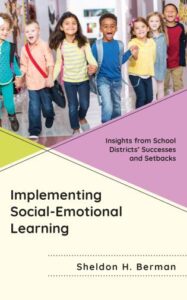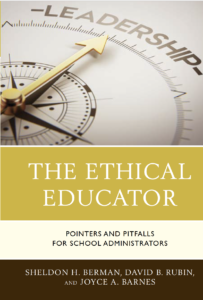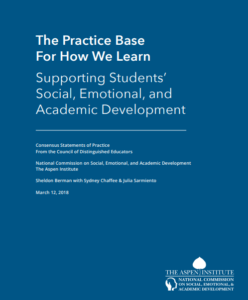Implementing Social-Emotional Learning: Insights from School Districts’ Successes and Setbacks
SHELDON H. BERMAN
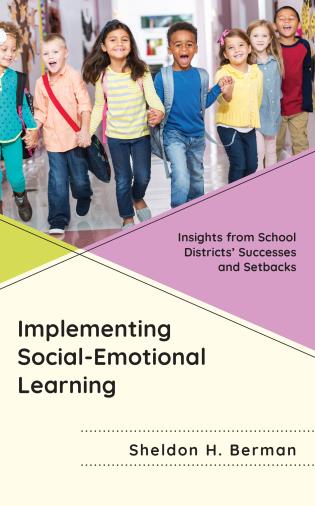
Implementing Social-Emotional Learning: Insights from Districts’ Successes and Setbacks provides essential insights into the strategies that have enabled districts to effectively provide the benefits of social-emotional learning to their students. Building on case studies of six school districts that vary in size, geographic region, demographic diversity, per-pupil spending, staff capacity, and leadership style, this book offers indispensable observations about the factors that facilitate the deep integration of SEL into daily instruction and school culture. While the approaches these districts have taken vary in type and degree, clear-cut themes emerge that are common to the most successful strategies.
Building upon these case studies, Implementing Social-Emotional Learning: Insights from Districts’ Successes and Setbacks offers clear guidance so districts can avoid the errors that compromise implementation and can, instead, support district leaders in building successful and sustainable approaches that reach all students, including those at the challenging middle and high school levels.
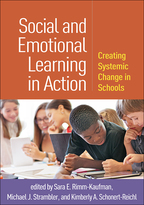
Excerpt from the chapter 10: The SEL Roadmap: Avoiding the Roadblocks, Ruts, and Dead Ends by Sheldon Berman, Jacqueline Jodl, and Joyce Barnes.
As with many initiatives in education, the road to systemic implementation of SEL is embarked upon with good intentions—and then the obstacles come into view around the bend. The field of SEL has grown dramatically as districts’ SEL programming expanded in the United States. What we know from observing this expansion is that districts begin at very different points and set off down this path motivated by widely divergent rationales. Some districts start by formulating well-intentioned and well-designed strategic plans; others choose opportunistic moments that catch the imagination and interest of faculty and administrators; and still others seize upon SEL as a vehicle to address an urgent crisis. Each district follows a unique path based on the context of its cultural and political environment. It is clear that there is no one best path, or one best program; rather, for those who would make progress, there is a layering of program development and a gradual deepening of fidelity to a vision. This chapter, then, is intended not so much to provide a uniform roadmap as it is to let those who have chosen this road know where the obstacles, ruts, and roadblocks may lie, so that strategies can be put in place to effectively avoid or work through them.
Interview for Research for Better Teaching >
Tribute-to-Weissberg-and-SchapsCommunicating the “Learning” in Social Emotional Learning – Learning Policy Institute >
CAS.2.0005Download the Case Study Here >
Berman-Implementing-SELDownload the Presentation Here >
What Works in Education
In this Edutopia.org article on Social and Emotional Learning, Sheldon Berman and other experts discuss how educating the whole child by including social and emotional skills with academics is critical for success in school and in life.
Watch Sheldon’s full interview below:
(opens in a new tab)”>Watch the Full 4-Part Series Here >
Citations:
Remembering Two Who Brought Us to SEL. School Administrator, Vol. 79, No. 2, February 2022.
A path to equity paved by social-emotional learning. School Administrator, Vol. 78, No. 7, August 2021.
SEL Playbook for Superintendents, Panorama Education June 2020.
A Compelling Moment for Social-Emotional Learning, Education and Career News, March 23, 2021
SEL Leadership In A Virtual World, AASA May 2020
Equity: At the Heart of Social-Emotional Learning. A, C & E Magazine, March 2020.
Practice Agenda in Support of How Learning Happens (with Ron Berger, Joshua Garcia and John Desse). Report of National Commission on Social, Emotional and Academic Development, The Aspen Institute, Washington, D.C., January 14, 2019.
The Hechinger Report “This is the teaching that prepares kids for real life – and it’s no longer optional,” April 12, 2018.Hechinger Report
Implementing Social Emotional Learning. School Administrator, Vol. 75, No. 8, September 2018.
Social development, school culture, and academic performance. Beyond Bullying Summit, Teachers College, Columbia University, N.Y., January 14, 2013
The district superintendent’s role in supporting prosocial education (with Florence C. Chang and Joyce A. Barnes). In Ann Higgins-D’Alessandro, Phil Brown, Mike Corrigan, and Betty W. Straub (Eds.), The Prosocial Education Handbook. Lanham, MD: Rowman & Littlefield, 2012.
The connection between character, service, and social-emotional learning, (with M. McCarthy). In M.J. Elias & H. Arnold, (Eds.), The Educator’s Guide to Emotional Intelligence and Academic Achievement: Social-emotional Learning in the Classroom. Thousand Oaks, CA: Corwin Press, 2006.
Safe and Sound: An educational leader’s guide to evidence-based social and emotional learning programs-Illinois Edition. Collaborative for Academic, Social, and Emotional Learning (CASEL), February 2005.
School as a moral community (with Diane Berreth and Susan Anderson). In Amitai Etzioni (Ed.), Character Building for a Democratic, Civil Society. Washington D.C.: The Communitarian Network, 1997.
The moral dimensions of school (with Diane Berreth). Educational Leadership, Vol. 54, No. 8, May 1997.
The practice base for how we learn: Supporting students’ social, emotional, and academic development (with Sydney Chaffee and Julia Sarmiento).
